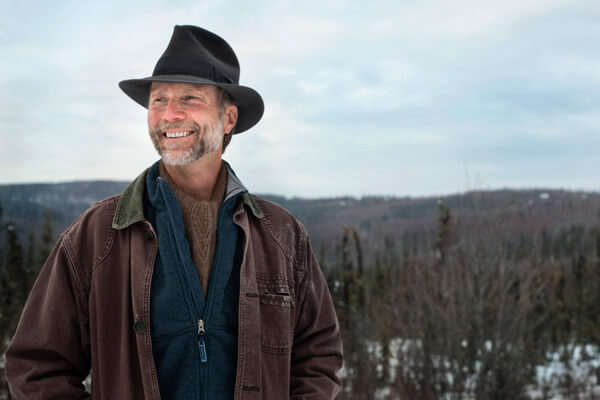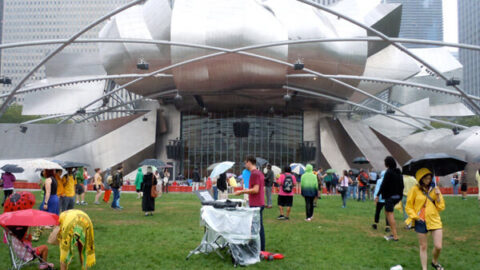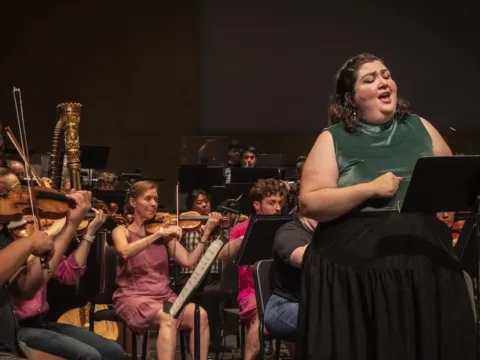 In a modern world too often marked by conflicts of humanity versus nature, an exhilarating human communing with nature unfolded in the pouring rain on the fields of that most modern of landscapes, Chicago Millennium Park, on Sunday afternoon, August 26, 2012. Over 100 musicians, led by eighth blackbird and production designer Doug Perkins, performed John Luther Adams’ epic Inuksuit as they mingled with an audience of several hundred stalwart music fans.
In a modern world too often marked by conflicts of humanity versus nature, an exhilarating human communing with nature unfolded in the pouring rain on the fields of that most modern of landscapes, Chicago Millennium Park, on Sunday afternoon, August 26, 2012. Over 100 musicians, led by eighth blackbird and production designer Doug Perkins, performed John Luther Adams’ epic Inuksuit as they mingled with an audience of several hundred stalwart music fans.

Adams, who lives and works primarily in Alaska, conceived of Inuksuit as much as an environmental experience as a music performance. The title is an Inuit word that means “to act in the capacity of the human” and refers to stacked stone sentinels built over the centuries by the peoples of the Arctic. Inuksuit of varied styles and sizes are found marking important sites — migration routes, fishing grounds, memorials — throughout the aboriginal areas of Alaska and Canada. Adams uses this singularly Arctic symbol as a means to require the performers and the audience to confront fundamental questions about who we are, where and how we live, what it means to act in the capacity of a human in an environment in crisis.
Millennium Park, Chicago’s new jewel by the lake, promised to be an opportune setting for staging Inuksuit. Its starkly modern landscape featuring the architecture of Frank Gehry and Renzo Piano incites questions of human relationships to the environment. Perkins and members of eighth blackbird made a thorough examination of the unique topology and features of the park to determine how best to use it a stage for presenting Inuksuit. They designed an elaborate site plan (see graphic) to deploy musicians and instruments radiating out from the music pavilion and lawn area into the Lurie Gardens and on Piano’s bridge to the Art Institute.
Despite his extensive advance planning, a persistent storm system put Perkins’ plans in jeopardy. When we arrived at rainy Millennium Park, the Great Lawn of Gehry’s Pritzker Pavilion was nearly empty save for scattered sets of drums, cymbal trees, and glockenspiels like so many inuksuit harbingers of the experience to come. The stacks of instruments were covered with plastic, tarps and other protective devices in hopes the steady rain would subside. But as performance time approached the forecast never wavered from 100% chance of rain. A crowd began to assemble and word spread that plans to deploy instruments and musicians broadly throughout the park were scrapped. But the musicians were adamant they would perform unless there was lightning.

Would the rain prove to be more than these indomitable musicians bargained for? It would not! At the appointed hour of 5:30, 101 musicians began to slowly and quietly convene in an amorphous formation in the center of the Great Lawn as the crowd gathered around them. The music began with sounds evoking the Arctic winds, some players blowing through large paper cones, others using conch shells. The rain suddenly held off.
As the performers began to wade through the crowd and spread out, wind noises gave way to clarion calls on the conch shells, eerie whirring noises from swirling flexible plastic hoses, scratching sounds of wood rubbed on wood and stone rubbed on stone. Performers assigned to the percussion stacks reached their positions and poised to play. Suddenly, eighth blackbird percussionist Matthew Duvall struck a thunderous boom on an oversized bass drum, unleashing a cacophony of sound throughout the Great Lawn and Pavilion. And just as suddenly the heaviest rain of the day burst forth. In this piece about communing with nature, we were all completely engulfed by it.
Inuksuit is designed as a participatory piece, with the performers immersed in the audience so there is no one ideal place from which to experience the soundscape. We found ourselves promenading throughout the pavilion area with the same ritualistic style and pace of Doug Perkins’ organically choreographed movements for the performers. Some of us were equipped with rain gear and umbrellas. Others simply allowed the rain to soak them. The magical combination of music and rain unleashed an innocent abandon in the crowd: a little girl running in a “catch me if you can” game with her father, a man sticking out his tongue to catch the rainwater, some in mediative poses with their eyes closed, others holding umbrellas over musicians. No one, it seemed, had any inclination to leave.
The music continued to move in waves from one group of musicians to another, mesmerizing the crowd in its thrall. The dominant notes came from the stationary sets of drums, cymbals, gongs and hand-cranked sirens. Wandering performers added accents by striking triangles, metal bars, and metal tubes. From the stage of the pavilion, safe from the potential water damage, piccolo trills rang out. The waves and crescendos of sound mutated continuously as one wandered about. The rain added its own percussive notes, dancing off taught umbrellas and splashing in growing puddles. The light took on a special glow, reminiscent of the Arctic midnight sun.
Slowly the sounds softened to the level of bird calls, carried primarily by the glockenspiels, triangles, and piccolos. Many performers began a ritualistic promenade back to the center of the Great Lawn, attracting the crowd with them. Gently the music died out, eventually replaced by sustained applause, hoops, and hollers from an intensely joyous audience. The musicians were mostly soaked through to the skin, some visibly shivering; all were clearly exhilarated by their triumphant performance of Inuksuit.
Congratulations and our profound thanks go out to the full roster of performers:
Director – Doug Perkins
eight blackbird – Lisa Kaplan, Tim Munro, Yvonne Lam, NIck Photinos, Matthew Duvall, Michael Maccaferri, Ryan Ingegritsen
Calumet Chamber Musicians – John Wachala
Chicago Civic Orchestrea – Eliza Bangert
Coalescence Percussion Duo – Judy Moonert, Greg Secor
DePaul University – Robert Fletcher
Eastern Illinois University – Jamie Ryan
Ensemble Dal Niente – Shanna Gutierrez, Ammie Brod
Fifth House Ensemble – Matt Monroe, Herine Koschak, Ross Weijer
Fulcrum Point – Kate Flum
Grand Valley State University – Bill Ryan, Dan Rhode, Adam Cuthbert, Josh Dreyer, Sam Gould
Illinois Percussive Arts Society – Jeff Strong, Jeff Brenner
Indiana University – Greg Mesa
Moraine Valley Community College – Andrew Novak, Julio Jimenez, Ben Lisak, Maura Vizza
Naperville High School – Ben Walhund
New Millennium Orchestra -Emma Hospelhorn
New Music Chicago – Jeff Shaw, Andrew Tham, Jennie Brown
Northern Illinois University -Greg Beyer, Brian Wach, Alexis Lamb, Mike Mixtack, Nick Fox, Dan Eastwood, Greg Essig, Zane Cupec, Austin Shoupe, Jonny Gifford, Chris Mrofzca, Daniel Henson, Angela Kepley, Jaime Esposito, Tim Mcallister
Palomar -Alicia Poot
Roosevelt University – Nathan Bushey
Third Coast Percussion – Rob Dillon, Peter Martin, Dave Skidmore, Clay Condon
University of Chicago – Shawn Allison
University of Illinois, Urbana/Champaign – Gavin Ryan, Dan McLaughlin, Peter Breithaupt, William Mullen, Tom Siwe
University of Michigan – Josh Graham, Dylan Greene, Jon Brown, Chris Sies
University of Wisconsin at Stevens Point – Tom Bjoraker, Kel Kelley, Rebecca Kolonick, Sean Conners, Matt Clark, Jeff Crowell, Bri Trainor, Andrew Cameron, Andy Neidner, Carissa Tikalsky, Alex Meronek
Other: Yael Litwin, Chris Jasinsky, Ben Runkell, Daniel Reifsteck, Chris Dandeles, Paul Beckman, Emilie Mitchell, Doug Bratt, Christina Foster, Chris Jones, Alan Fey, Megan Arns, Amy Garapic, Ben Fraley, Aaron Butler, John Corkill, Jake Coon, Brett Baxter, Trevor Saint, Simon Munro, Alex Hough, Gabe Gaster
—
Arlene and Larry Dunn are pure amateurs of contemporary music. Visit their blog at Acornometrics and follow them on Twitter: @ICEfansArleneLD
























